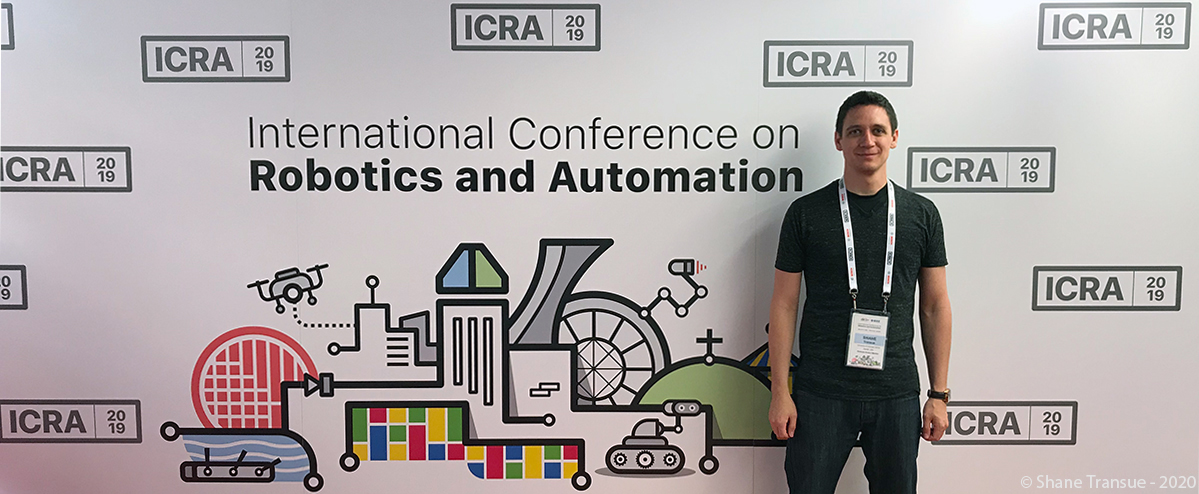Research in Computer Science and Engineering incorporates multifaceted development projects that create practical solutions to complex problems. While I have several different research interests and directions, most of my work integrates interdisciplinary work with computer graphics or scientific visualization. This page lists all of my peer-reviewed publications as well as other published work, technical write-ups, and presentations.
Peer-Reviewed Publications
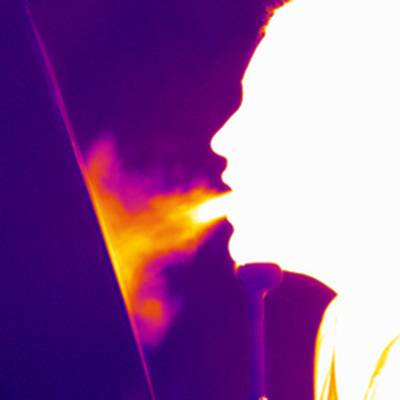
Non-contact Medium-based Respiratory Analysis through Reinforced Hybrid Model
Abstract: The ability to monitor natural respiratory behaviors is essential to pulmonology. Existing contact-based respiratory monitoring methods are known for their accuracy, but are generally considered uncomfortable, whereas non-contact methods are comfortable but less accurate. Thin Medium Thermal Imaging (TMTI), a respiration monitoring method that uses a thin medium and thermal imaging to sense breathing activity, was proposed as an alternative non-contact method that monitors respiration directly. However, the accuracy of this method suffered due to lack of information about airflow behaviors occurring between the user’s mouth and the medium. In this paper, we describe a reinforced hybrid model that utilizes a thermal camera with a spectral filter (3-5[µm]) to provide breathing behavior information in addition to a low-cost thermal camera to capture images of the medium. The thermal camera with a spectral filter visualizes CO2, giving us the ability to observe the turbulent behavior of exhaled airflows. By further understanding the relationship between human breathing behaviors and the heat signatures on the medium using this hybrid model, we are able to classify breathing mode with at least 91% accuracy.
Breawn Schoun, Shane Transue and Min Choi, “Non-contact Medium-based Respiratory Analysis through Reinforced Hybrid Model,” 2019 IEEE SENSORS, Montreal, QC, Canada, pp. 1-4, 2019.
[IEEE Xplore] [PDF] [Bibtex]
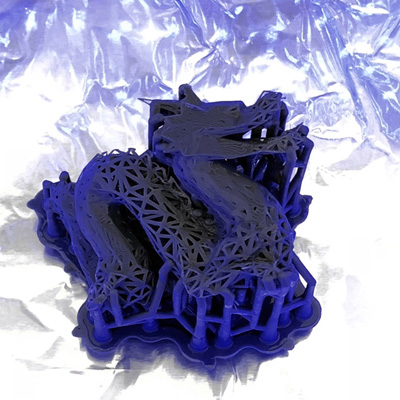
Generative Deformation: Procedural Perforation for Elastic Structures
Abstract: Procedural generation of elastic structures provides the fundamental basis for controlling and designing 3D printed deformable object behaviors. The automation through generative algorithms provides flexibility in how design and functionality can be seamlessly integrated into a cohesive process that generates 3D prints with variable elasticity. Generative deformation introduces an automated method for perforating existing volumetric structures, promoting simulated deformations, and integrating stress analysis into a cohesive pipeline model that can be used with existing consumer-level 3D printers with elastic material capabilities. In this work, we present a consolidated implementation of the design, simulate, refine, and 3D print procedure based on the automated generation of heterogeneous lattice structures. We utilize Finite Element Analysis (FEA) metrics to generate perforated deformation models that adhere to deformation behaviors created within our design environment. We present the core algorithms, automated pipeline, and 3D print deformations of various objects. Quantitative results illustrate how the heterogeneous geometric structure can influence elastic material behaviors towards design objectives. Our method provides an automated open-source tool for quickly prototyping elastic 3D prints.
Shane Transue and Min Choi, “Generative Deformation: Procedural Perforation for Elastic Structures”, IEEE International Conference on Robotics and Automation (ICRA’19), Palais des congres de Montreal, Montreal, Canada, pp. 3672-3678, 2019.
[IEEE Xplore] [PDF] [YouTube] [Bibtex]
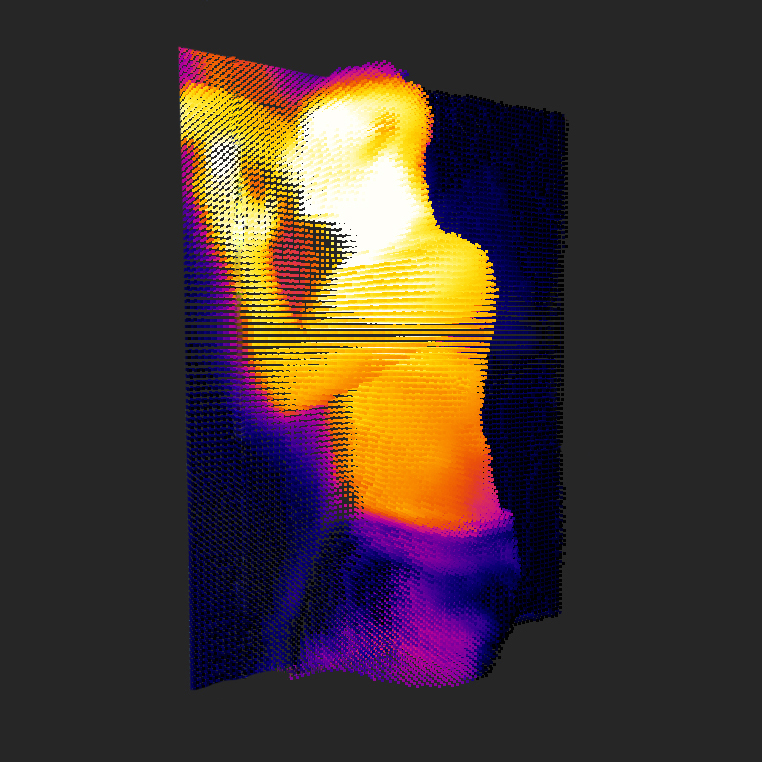
Volumetric Reconstruction of Thermal-depth Fused 3D Models for Occluded Body Posture
Abstract: Reliable and effective occluded skeletal posture estimation is a challenging problem for vision-based modalities that do not provide inter-surface imaging. These include both visible-light and depth-based devices that all existing pose estimation techniques are derived from. This fundamental limitation in skeletal tracking is due to the inability of these techniques to penetrate occluding surface materials to derive joint configurations that are not directly visible to the camera. In this work, we present a new method of estimating skeletal posture in occluded applications using both depth and thermal imaging through volumetric modeling and introduce a new occluded ground-truth tracking method inspired by modern motion capture solutions for tracking occluded joint positions. Using this integrated volumetric model, we utilize Convolutional Neural Networks to characterize and identify volumetric thermal distributions that match trained skeletal posture estimates which includes disconnected skeletal definitions and allows correct posture estimation in highly ambiguous cases. We demonstrate this approach by accurately identifying common sleep postures that present challenging cases for current skeletal joint estimation techniques and evaluate the use of volumetric thermal models for various sleep-study related applications.
Shane Transue, Phuc Nguyen, Tam Vu, Min-Hyung Choi, “Volumetric reconstruction of thermal-depth fused 3D models for occluded body posture estimation”, Smart Health Journal, Volume 11, Pages 29-44, 2019.
[Science Direct] [PDF] [Bibtex]
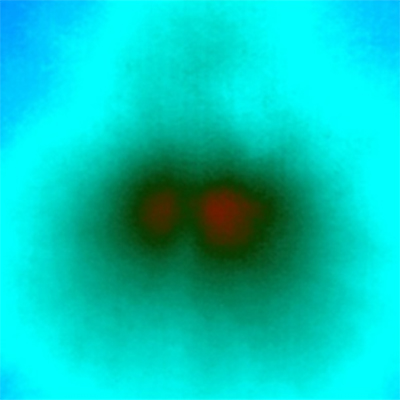
Non-Contact Tidal Volume Measurement through Thin Medium Thermal Imaging
Abstract: Tidal volume (TV) is frequently measured by pulmonologists to assess the breathing ability and respiratory behaviors of a patient. The most common method of measuring tidal volume, spirometry, generally requires the patient to breathe through a tube while wearing a nose clip. This method of measurement is uncomfortable for the patient, and alters their natural breathing behaviors. In this paper, we describe and implement a new approach to respiration monitoring and tidal volume estimation that preserves patient comfort while maintaining measurement accuracy. In this method, a patient breathes onto a thin medium placed perpendicular to the patient׳s exhaled airflow while a thermal camera records the heat signature on the opposite side of the medium. Measurements such as tidal volume, respiration rate, and nose to mouth distribution are extracted from these thermal images, correlated with ground-truth measurements and trained into a recurrent network model using TensorFlow. This method is comfortable for the patient, works for a variety of different body types and ages, and can be used in the comfort of an out-patient office.
Breawn Schoun, Shane Transue, Ann C. Halbower, and Min-Hyung Choi, “Non-contact tidal volume measurement through thin medium thermal imaging”, Smart Health Journal, Volumes 9–10, Pages 37-49, 2018.
[Science Direct] [PDF] [YouTube] [Bibtex]
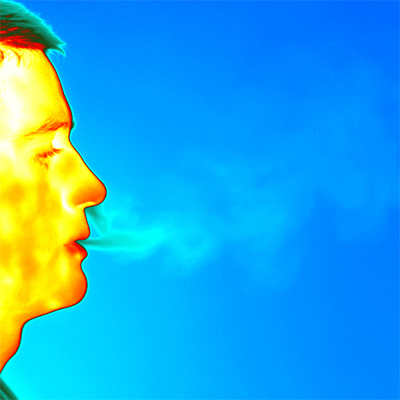
Behavioral analysis of turbulent exhale flows
Abstract: Dense exhale flow through CO 2 spectral imaging introduces a pivotal trajectory within non-contact respiratory analysis that consolidates several pulmonary evaluations into a single coherent monitoring process. Due to technical limitations and the limited exploration of respiratory analysis through this non-contact technique, this method has not been fully utilized to extract high-level respiratory behaviors through turbulent exhale analysis. In this work, we present a structural foundation for respiratory analysis of turbulent exhale flows through the visualization of dense CO 2 density distributions using precisely refined thermal imaging device to target high-resolution respiratory modeling. We achieve spatial and temporal high-resolution flow reconstructions through the cooperative development of a thermal camera dedicated to respiratory analysis to drastically improve the precision of current exhale imaging methods. We then model turbulent exhale behaviors using a heuristic volumetric flow reconstruction process to generate sparse flow exhale models. Together these contributions allow us to target the acquisition of numerous respiratory behaviors including, breathing rate, exhale strength and capacity, towards insights into lung functionality and tidal volume estimation.
Shane Transue, Sayed M. Reza, Ann C. Halbower and Min Choi, “Behavioral analysis of turbulent exhale flows,” IEEE EMBS International Conference on Biomedical & Health Informatics (BHI’18), Las Vegas, NV, pp. 42-45, 2018. Best Paper Award
[Xplore] [Pdf] [Bibtex]
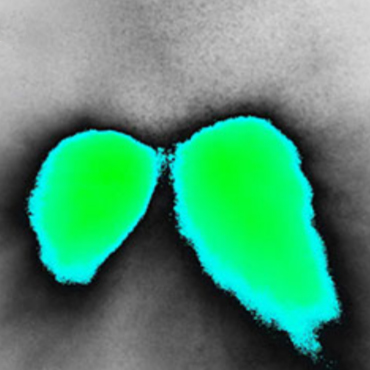
Non-contact comprehensive breathing analysis using thermal thin medium
Abstract: Respiration monitoring methods that are both accurate and comfortable are highly sought after in the medical field. No existing method of respiration monitoring perfectly satisfies both of these criteria; each method is a trade-off between comfort and accuracy. Contact methods, which require placing sensors directly on the patient’s body, provide reliable measurements, but are uncomfortable for the patient, which alters their natural breathing behaviors. Conversely, non-contact methods monitor respiration remotely and comfortably, but with lower accuracy. We present a method of respiratory analysis that is non-contact, but also measures the exhaled air of a human subject directly through a medium-based exhale visualization technique. In this method, we place a thin medium perpendicular to the exhaled airflow of an individual, and use a thermal camera to record the heat signature from the exhaled breath on the opposite side of the material. Breathing rate and respiratory behaviors are extracted from the thermal data in real time. Our proposed respiration monitoring technique accurately reports breathing rate, and provides other information not obtainable through other non-contact methods. This method can be implemented as a small low-cost device for ease of use in a clinical environment.
Breawn Schoun, Shane Transue, Ann C. Halbower and Min Choi, “Non-contact comprehensive breathing analysis using thermal thin medium,”IEEE EMBS International Conference on Biomedical & Health Informatics (BHI’18), Las Vegas, NV, pp. 239-242, 2018.

Optimization of Material Properties for Coherent Behavior across Multi-resolution Cloth Models
Abstract: This paper introduces a scheme for optimizing the material properties of mass-spring systems of different resolutions to provide coherent behavior for reduced level-of-detail in MSS(Mass-Spring System) meshes. The global optimal material coefficients are derived to match the behavior of provided reference mesh. The proposed method also gives us insight into levels of reduction that we can achieve in the systematic behavioral coherency among the different resolution of MSS meshes. We obtain visually acceptable coherent behaviors for cloth models based on our proposed error metric and identify that this method can significantly reduce the resolution levels of simulated objects. In addition, we have confirmed coherent behaviors with different resolutions through various experimental validation tests. We analyzed spring force estimations through triangular Barycentric coordinates based from the reference MSS that uses a Gaussian kernel based distribution. Experimental results show that the displacement difference ratio of the node positions is less than 10% even if the number of nodes of MSSsim decreases by more than 50% compared with MSSref. Therefore, we believe that it can be applied to various fields that are requiring the real-time simulation technology such as VR, AR, surgical simulation, mobile game, and numerous other application domains.
Nak-Jun Sung, Shane Transue, Minsang Kim, Yoo-Joo Choi, Min Choi and Min Hong, “Optimization of Material Properties for Coherent Behavior across Multi-resolution Cloth Models,” KSII Transactions on Internet and Information Systems, vol. 12, no. 8, pp. 4072-4089, 2018.
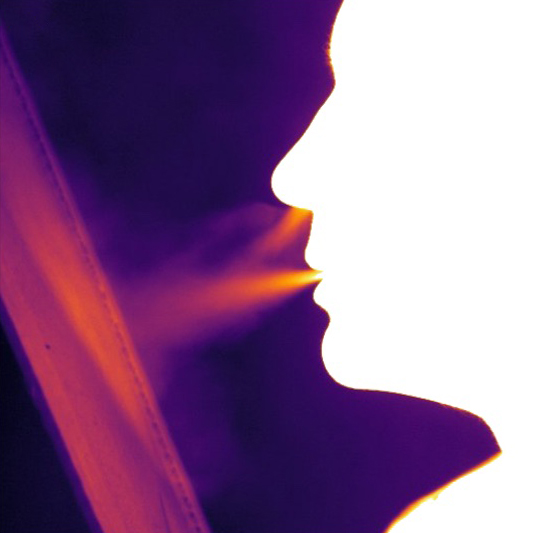
Real-time Thermal Medium-based Breathing Analysis with Python
Abstract: Respiration monitoring is an important physiological measurement taken to determine the health of an individual. In clinical sleep studies, respiration activity is monitored to detect sleep disorders such as sleep apnea and respiratory conditions such as Chronic Obstructive Pulmonary Disease (COPD). Existing methods of respiration monitoring either place sensors on the patient’s body, causing discomfort to the patient, or monitor respiration remotely with lower accuracy. We present a method of respiratory analysis that is non-contact, but also measures the exhaled air of a human subject directly through a medium-based exhale visualization technique. In this method, we place a thin medium perpendicular to the exhaled airflow of an individual, and use a thermal camera to record the heat signature from the exhaled breath on the opposite side of the material. Respiratory behaviors are extracted from the thermal data in real time using Python. Our prototype is an embedded, low-power device that performs image and signal processing in real-time with Python, making use of powerful existing Python modules for scientific computing and visualization. Our proposed respiration monitoring technique accurately reports breathing rate, and may provide other metrics not obtainable through other non-contact methods. This method can be useful for medical applications where long-term respiratory analysis is necessary, and for applications that require additional information about breathing behavior.
Breawn Schoun, Shane Transue, and Min-Hyung Choi. “Real-time Thermal Medium-based Breathing Analysis with Python.” In Proceedings of the 7th Workshop on Python for High-Performance and Scientific Computing (PyHPC’17). Association for Computing Machinery (ACM), NY, USA, Article 5, 1–9, 2017.
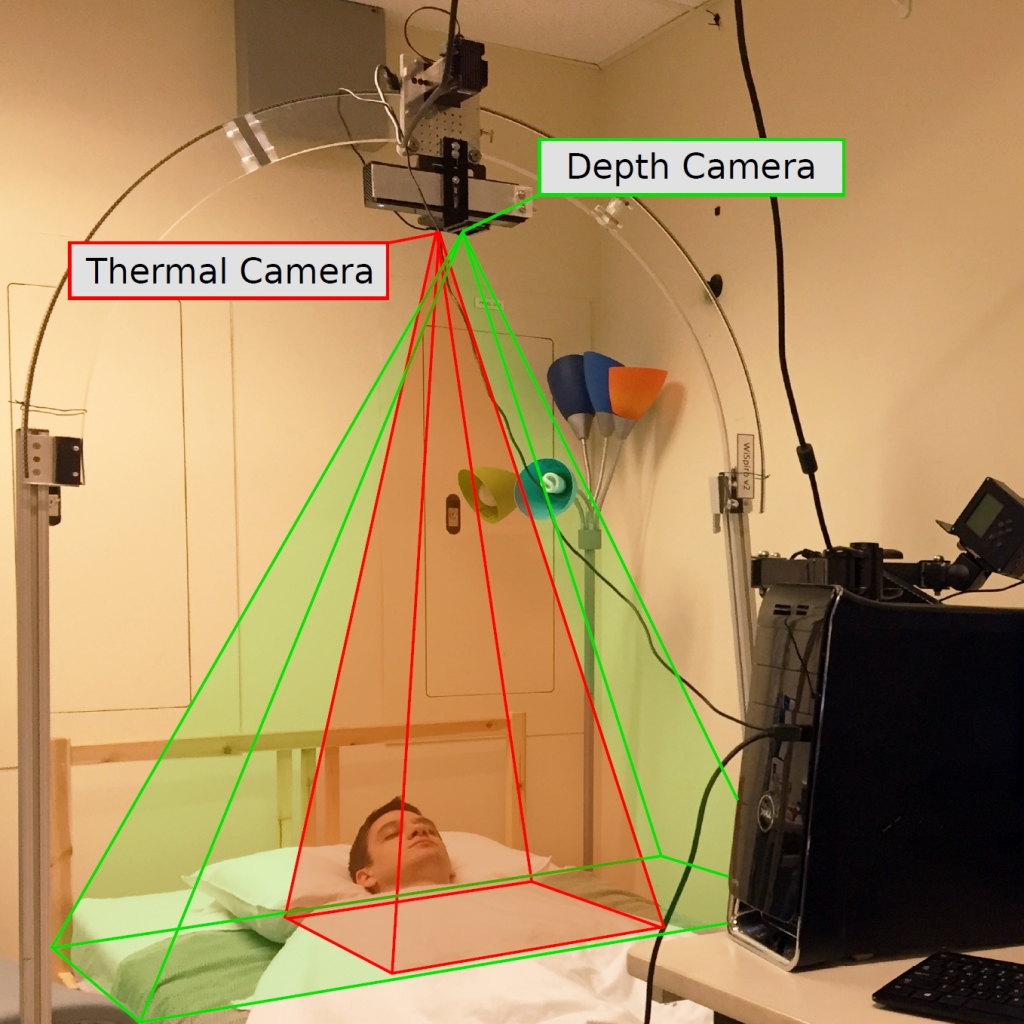
Thermal-Depth Fusion for Occluded Body Skeletal Posture Estimation
Reliable occluded skeletal posture estimation is a fundamentally challenging problem for vision-based monitoring techniques. This is due to several imaging related challenges introduced by existing depth-based pose estimation techniques that fail to provide accurate joint position estimates when the line of sight between the imaging device and the patient is obscured by an occluding material. In this work, we present a new method of estimating skeletal posture in occluded applications using both depth and thermal imaging through volumetric modeling and introduce a new occluded ground-truth tracking method inspired by modern motion capture solutions. Using this integrated volumetric model, we utilize Convolutional Neural Networks to characterize and identify volumetric thermal distributions that match trained skeletal posture estimates which includes disconnected skeletal definitions and allows correct posture estimation in highly ambiguous cases. We demonstrate this approach by correctly identifying common sleep postures that present challenging cases for current skeletal joint estimations, obtaining an average classification accuracy of ~94.45%.
Shane Transue, Phuc Nguyen, Tam Vu and Min Choi, “Thermal-Depth Fusion for Occluded Body Skeletal Posture Estimation,” IEEE/ACM International Conference on Connected Health: Applications, Systems and Engineering Technologies (CHASE), Philadelphia, PA, pp. 167-176, 2017.
[IEEE Xplore] [PDF] [YouTube] [Bibtex]
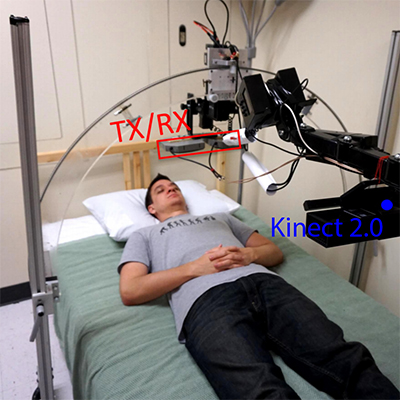
WiKiSpiro: non-contact respiration volume monitoring during sleep
Abstract: Respiration volume has been widely used as an important indication for diagnosis and treatment of pulmonary diseases and other health care related issues such as critically ill patients neonatal ventilation, post-operative monitoring and various others. Most of existing technologies for respiration volume monitoring require physical contact with the human body. While wireless-based approaches have also been discussed in the literature, there are still limitations in terms of estimation accuracy and time efficiency preventing these approaches from being realized in practice. In this paper, we present an automated, wireless-based, vision-supervised system, called WiKiSpiro, for monitoring an individual’s respiration volume. In particular, we present a system design encompassing a wireless device, motion tracking and control system, and a set of methods to accurately derive breathing volume from the reflected signal and to address challenges caused by body movement and posture changes. We present our preliminary results of WikiSpiro, and identify possible challenges for future research and development.
Phuc Nguyen, Shane Transue, Min-Hyung Choi, Ann C. Halbower, and Tam Vu. 2016. WiKiSpiro: non-contact respiration volume monitoring during sleep. In Proceedings ACM S3. Association for Computing Machinery (ACM), New York, USA, 27–29, 2016. Best Paper Award
[Johns Hopkins] [ACM] [PDF] [Bibtex]
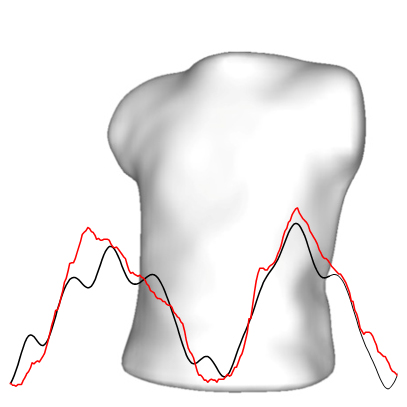
Real-Time Tidal Volume Estimation Using Iso-surface Reconstruction
Abstract: Breathing volume measurement has long been an important physiological indication widely used for the diagnosis and treatment of pulmonary diseases. However, most of existing breathing volume monitoring techniques require either physical contact with the patient or are prohibitively expensive. In this paper we present an automated and inexpensive non-contact, vision-based method for monitoring an individual’s tidal volume, which is extracted from a three-dimensional (3D) chest surface reconstruction from a single depth camera. In particular, formulating the respiration monitoring process as a 3D space-time volumetric representation, we introduce a real-time surface reconstruction algorithm to generate omni-direction deformation states of a patient’s chest while breathing, which reflects the change in tidal volume over time. These deformation states are then used to estimate breathing volume through a per-patient correlation metric acquired through a Bayesian-network learning process. Through prototyping and implementation, our results indicate that we have achieved 92.2% to 94.19% accuracy in the tidal volume estimations through the experimentation based on the proposed vision-based method.
Shane Transue, Phuc Nguyen, Tam Vu and Min Choi, “Real-Time Tidal Volume Estimation Using Iso-surface Reconstruction,” IEEE First International Conference on Connected Health: Applications, Systems and Engineering Technologies (CHASE), Washington, DC, pp. 209-218, 2016.
[IEEE Xplore] [PDF] [YouTube] [Bibtex]
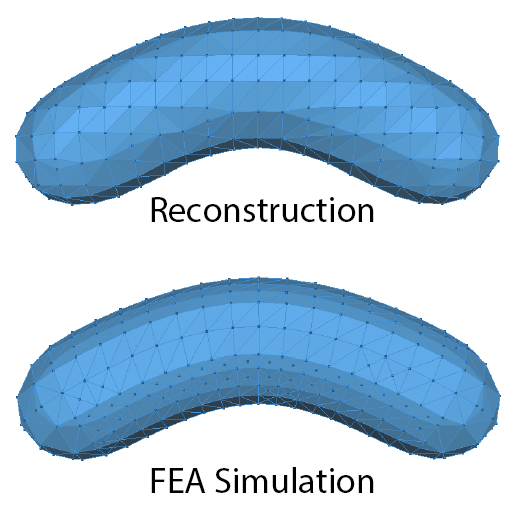
Deformable Object Behavior Reconstruction Derived Through Simultaneous Geometric and Material Property Estimation
Abstract: We present a methodology of accurately reconstructing the deformation and surface characteristics of a scanned 3D model recorded in real-time within a Finite Element Model (FEM) simulation. Based on a sequence of generated surface deformations defining a reference animation, we illustrate the ability to accurately replicate the deformation behavior of an object composed of an unknown homogeneous elastic material. We then formulate the procedural generation of the internal geometric structure and material parameterization required to achieve the recorded deformation behavior as a non-linear optimization problem. In this formulation the geometric distribution (quality) and density of tetrahedral components are simultaneously optimized with the elastic material parameters (Young’s Modulus and Possion’s ratio) of a procedurally generated FEM model to provide the optimal deformation behavior with respect to the recorded surface.
Shane Transue and Min-Hyung Choi, “Deformable Object Behavior Reconstruction Derived Through Simultaneous Geometric and Material Property Estimation”, Advances in Visual Computing, pp. 474–485, Las Vegas, NV, 2015.
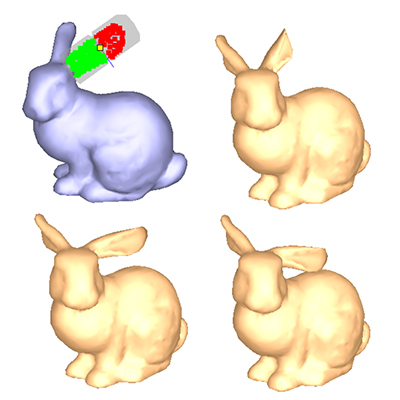
Interactive Control of Deformable-object Animations through Control Metaphor Pattern Adherence
Abstract: In this paper we present an adaptive and intuitive methodology for controlling the localized deformations of physically simulated objects using an intuitive pattern-based control interface. To maximize the interactive component presented in this approach we consolidate existing feedback mechanisms in deformable-body control techniques to provide intuitive editing metaphors for stretching, bending, twisting, and compressing simulated objects. The resulting movements created by these control metaphors are validated using imposed behavior evaluation and the effectiveness of this approach is demonstrated through interactively generated compound movements that introduce complex local deformations of objects in existing physical animations.
Shane Transue and Min-Hyung Choi. Interactive Control of Deformable-object Animations through Control Metaphor Pattern Adherence. In Proceedings of the 10th International Conference on Computer Graphics Theory and Applications (GRAPP’15), SCITEPRESS – Science and Technology Publications, Lda, Setubal, pp. 294–305, 2015.
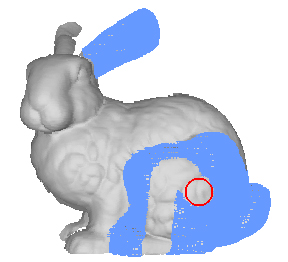
Intuitive Alignment of Point-Clouds with Painting-Based Feature Correspondence
Abstract: Throughout the course of several years, significant progress has been made with regard to the accuracy and performance of pair-wise alignment techniques; however when considering low-resolution scans with minimal pair-wise overlap, and scans with high levels of symmetry, the process of successfully performing sequential alignments in the object reconstruction process remains a challenging task. Even with the improvements in surface point sampling and surface feature correspondence estimation, existing techniques do not guarantee an alignment between arbitrary point-cloud pairs due to statistically-driven estimation models. In this paper we define a robust and intuitive painting-based feature correspondence selection methodology that can refine input sets for these existing techniques to ensure alignment convergence. Additionally, we consolidate this painting process into a semi-automated alignment compilation technique that can be used to ensure the proper reconstruction of scanned models.
Shane Transue and Min Choi, “Intuitive Alignment of Point-Clouds with Painting-Based Feature Correspondence.” Advances in Visual Computing. 2014.
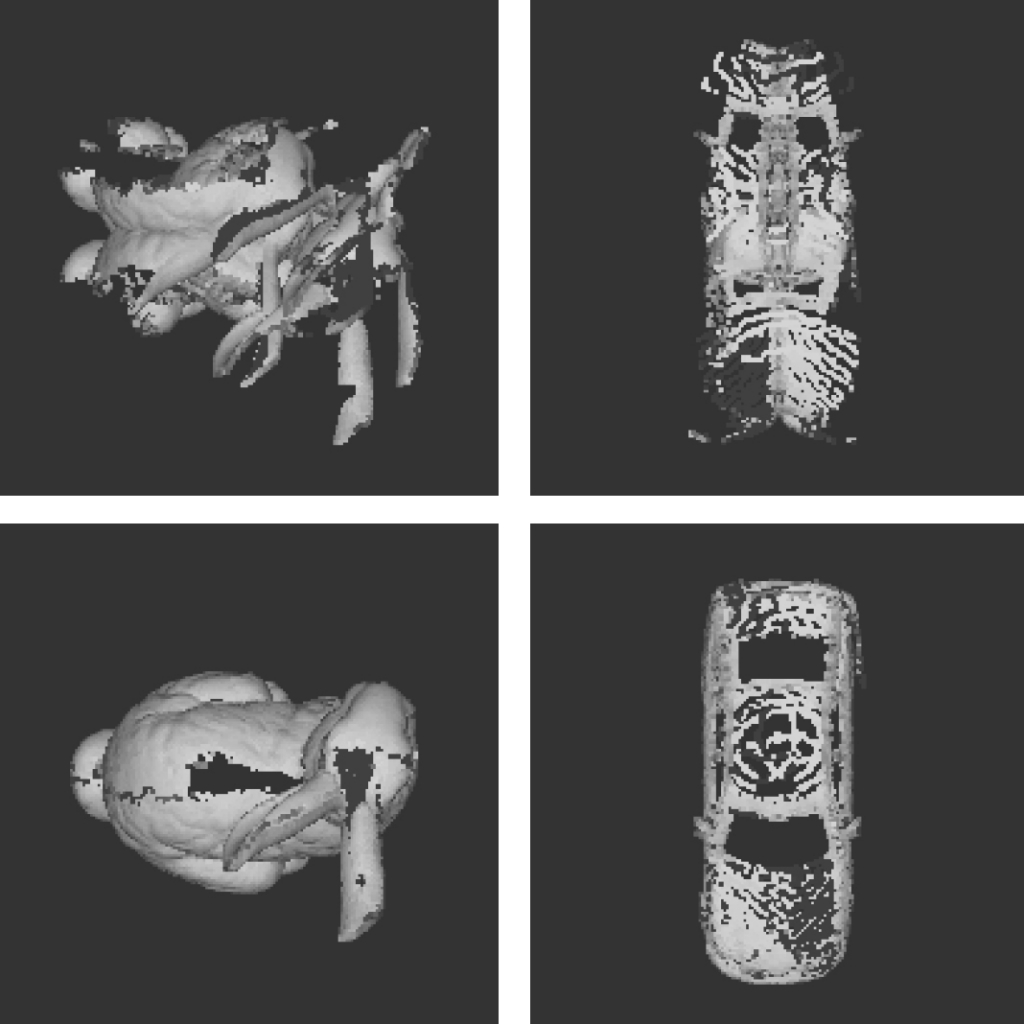
Enhanced Pre-conditioning Algorithm for the Accurate Alignment of 3D Range Scans
Abstract: The process of accurately aligning 3D range scans to reconstruct a virtual model is a complex task in generic circumstances. Yet by exploiting the data characteristics common to many mobile 3D scanning devices, we propose a two phase alignment solution that improves the alignment provided by the iterative closest point (ICP) algorithm. Current approaches target how the ICP algorithm aligns two range scans based on modifying minimization functions, sampling functions, and point correspondence techniques. However, while these approaches have provided subtle improvements in the alignment process, the ICP algorithm is still incapable of aligning low resolution range scans with very little overlap. Based on our proposed algorithm, we are able to increase the accuracy of the alignment provided by the ICP algorithm by 40% on low resolution scan pairs and we demonstrate the versatility of this approach by accurately aligning a variety scan pairs with small overlap regions.
Shane Transue and Min Choi, “Enhanced Pre-conditioning Algorithm for the Accurate Alignment of 3D Range Scans”, In proceedings of the International Conference on Image Processing, Computer Vision, & Pattern Recognition, 2013.
[Proceedings] [PDF] [YouTube] [Bibtex]
Ph.D Dissertation
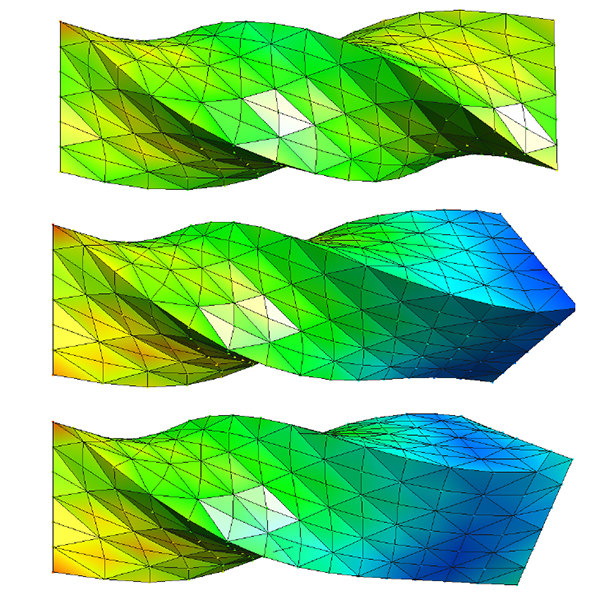
Inverse Modeling for Data-driven Physical Simulation
Abstract: Inverse modeling through data-driven methods introduces a new research direction for connecting analytical abstractions with real-world observations. In contrast to analytical modeling, the integration of data-driven and analytical methods allow us to characterize and reconstruct underlying physical phenomena of complex systems using discrete observations. This enables the creation of hybrid models that establish core behavioral characteristics driven by analytical methods that can be augmented with data-driven systems. As data-driven methods continue to enable alternative forms of computing efficient solutions to problems that are hard to explicitly solve through analytical methods, we adapt this paradigm shift to create elegant models representing various physical phenomena. In this dissertation, we present novel algorithms for the real-time simulation of data-driven elastic materials, behavior-driven procedural geometry for 3D printed elastic materials, and introduce new directions in detailed respiratory analysis through thermal imaging. Specifically, we introduce methods for creating real time data-driven Finite Element (FE) simulations for elastic materials, the automated perforation of volumetric meshes for 3D printing heterogeneous elastic materials, and introduce new quantitative metrics for vision-based respiratory analysis. We formulate, implement, and evaluate each of the proposed contributions to demonstrate the empowering nature of inverse modeling for computer aided design tools, interactive applications, and clinically deployable systems. Each of the proposed contributions defines an illustrative concept of how challenges in modeling complex real-world behaviors can be addressed through inverse modeling.
Shane Transue, “Inverse Modeling for Data-driven Physical Simulation”, Ph.D Dissertation, University of Colorado Denver, Denver, CO, 2019.
[PDF] [YouTube]
Masters Thesis
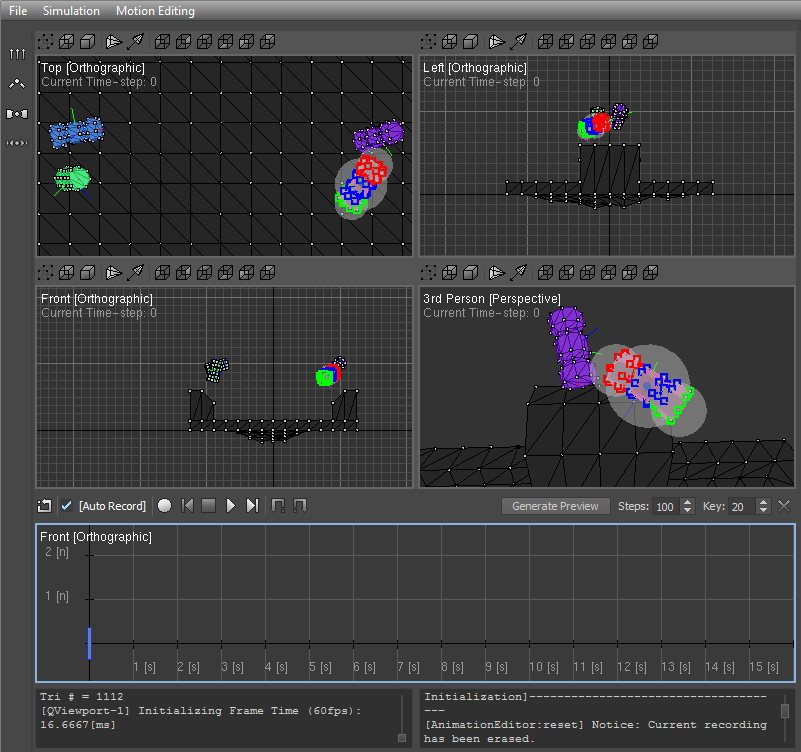
Interactive Control of Deformable-object Animations with Intuitive Motion Pattern Adherence
Abstract: Recent advances in the control of physically simulated objects have provided precise methodologies for deriving a desired physical state of a deformable object; however most of these approaches have severely limited the interactive component from real-time animation modification. To increase the level of interactivity in the generation of physically-based animations, we present an adaptive and intuitive methodology for controlling the localized deformation of physically simulated objects using an intuitive motion-based control interface. We achieve this control through the dynamic recording of physically simulated deformable objects and the development of high-level motion controls that provide effective manipulation techniques for altering the animation of deformable objects. To maximize the interactive component presented in this approach we consolidate existing feedback mechanisms in deformable-body control techniques to provide an intuitive simulation editing environment. We introduce the notion of control metaphors as the abstract formulations of primitive motions enacted by deformable-bodies when external forces modify the physical state of the object. As an application of this proposed control methodology we develop a practical solution for interjecting local deformations into dynamically recorded deformable objects. The effectiveness of this approach is demonstrated through interactively generated compound movements that introduce complex local deformations of the objects in existing physically-based animations. Additionally we validate the resulting movements imposed by the control metaphors by using directed behavior demonstrations through physical animations.
Shane Transue, “Interactive Control of Deformable-object Animations with Intuitive Motion Pattern Adherence”, MS Thesis, University of Colorado Denver, Denver CO, 2014.
[PDF] [YouTube]
Technical Papers
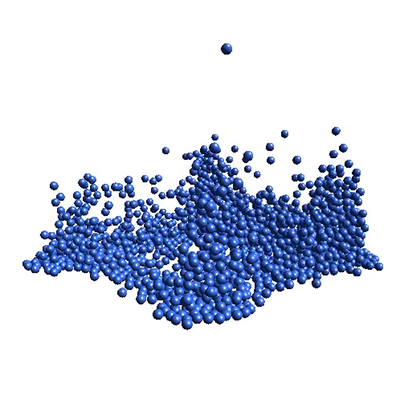
Parallel Fourier Parameterization and Impulse-based Cluster Collisions in Incompressible Particle-based Fluid Dynamics
Abstract: In this work we introduce and construct a framework of parallel algorithms that facilitate the parameterization and simulation of particle-based fluids. This parallel simulation framework is composed of three components: (1) the parameterization of the initial states of the simulated particles derived from Fourier analysis, (2) a set of discrete and continuous collision detection algorithms for particle and convex object interactions based on a newly introduced cluster-based event system, and (3) an impulse-based collision response algorithm for rigid-particle interaction. In the implementation of this framework we utilized both grouped SIMD facilitated through the Compute Unified Device Architecture (CUDA) and MIMD techniques through OpenMP to provide parallel implementations of efficient algorithms for each of these components. The collected results are demonstrated through the parameterization of waveforms to drive particle visualizations and the interactive simulation of particle-based fluid animation. Through the parallel implementations of our algorithms, we have been able to reduce our overall simulation time by approximately 80\% demonstrating a 5.37x increase in performance compared to the sequential implementation.
Shane Transue and Shannon Steinmetz. “Parallel Fourier Parameterization and Impulse-based Cluster Collisions in Incompressible Particle-based Fluid Dynamics”, Parallel and GPU Programming, University of Colorado Denver, 2016.
[PDF]
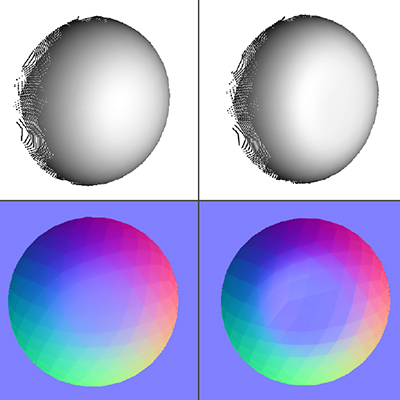
3D Surface Reconstruction for Deformation Analysis through Marker-less Image Processing
Abstract: Surface reconstruction from images based on the premise that geometric structures can be extracted using Shape From Shading (SFS) techniques is a well studied area within digital image processing. Most existing shape from shading methods focus on improving the quality of the surface that can be extracted based on improving surface curvature and depth estimations, however a new application of these techniques that has not been extensively studied is the application to surface deformation reconstructions of volumetric objects. The primary objective of this project is to: (1) explore current shape from shading techniques for surface reconstruction, (2) apply these techniques to deformation recording, and (3) improve surface curvature estimates of depth-images. Within the implementation of this project, several different techniques within digital image processing were used to reconstruct the animation of a deforming surface recorded using a Microsoft Kinect2. These include: intensity image acquisition, finite-difference based spatial convolution for image derivatives, normal map generation, and displacement map generation through field integration. The generated surfaces illustrate that the surface of a recorded deforming object can be accurately reconstructed using the proposed implementation.
Shane Transue, “3D Surface Reconstruction for Deformation Analysis through Marker-less Image Processing”, Graduate EE Image Processing, University of Colorado Denver, 2016.
[PDF]
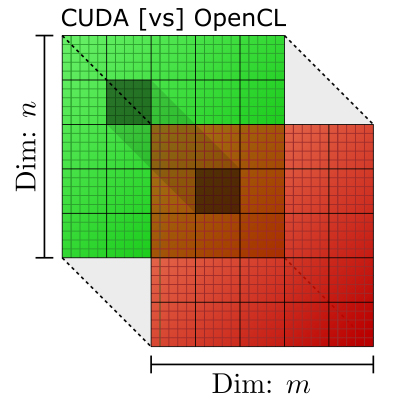
Performance Analysis of GPU Memory Architectures with Standard Matrix-Multiplication in OpenCL
Abstract: With the development of the uniform processor designs implemented in modern graphics processing units (GPUs) released by NVIDIA and AMD, the expansive development of parallel languages and frameworks allows us to create high performance parallel applications that exploit the architectural characteristics of these devices. Specifically, we look at the modern GPU memory hierarchy, the development of parallel algorithms in OpenCL and how fast on-chip local memory can be targeted to significantly increase the performance of modern parallel applications. We develop a standard benchmark, standard matrix multiplication in OpenCL, to analyze the desired performance gains achieved by using this memory. We have found that through the analysis of the elapsed execution time of our benchmark, the utilization of local on-chip memory versus global memory utilization has provided ~90% performance increase.
Shane Transue, Alejandro Alonso, and Sukthana Pongma. “Performance Analysis of GPU Memory Architectures with Standard Matrix-Multiplication in OpenCL”, Advanced Computer Architecture, University of Colorado Denver, 2012.
[PDF]
Patents
Min Choi, Shane Transue, and Ann Halbower, “Non-Contact Breathing Activity Monitoring And Analyzing Through Thermal And CO2 Imaging”, App No. 16/676346, 2020.
Various embodiments of the disclosed technology present a structural foundation for volumetric flow reconstructions for expiratory modeling enabled through multi-modal imaging for pulmonology. In some embodiments, this integrated multi-modal system includes infrared (IR) imaging, thermal imaging of carbon dioxide (CO 2), depth imaging (D), and visible spectrum imaging. These multiple image modalities can be integrated into flow models of exhale behaviors enable the creation of three-dimensional volume reconstructions based on visualized CO 2 distributions over time, formulating a four-dimensional exhale model which can be used to estimate various pulmonological traits (eg, breathing rate, flow rate, exhale velocity, nose/mouth distribution, tidal volume estimation, and CO 2 density distributions). Various embodiments also enable the accurate acquisition of numerous pulmonary metrics that are then …
Min Choi, Shane Transue, and Breawn Schoun, “Non-Contact Breathing Activity Monitoring And Analyzing System Through Thermal On Projection Medium Imaging”, US Patent App. 16/676,366, 2020.
Various embodiments of the present technology present a structural foundation for respiratory analysis of turbulent exhale flows through a technique called Thin Medium Thermal Imaging (TMTI). TMTI is a respiration monitoring method that uses a thin medium and thermal imaging to sense breathing activity. This technique is presented as an alternative to existing non-contact methods of respiratory analysis. As with all non-contact methods, remote monitoring of patients’ respiratory behaviors preserves patient comfort. However, unlike other respiratory monitoring methods, the TMTI method monitors respiration directly, and can therefore provide more respiratory information than other non-contact methods. Various embodiments may make use of different medium materials, different measurement setups, additional thermal imaging cameras and sensors, and setups with entertainment media such as Virtual Reality …
Shane Transue and Min Choi, “Thermal-Depth Fusion Imaging”, US Patent App. 16/131,659, 2019.
An imaging system is provided. The imaging system includes a 3D image capture device, which is configured to capture a depth image of an object, and a thermal image capture device, which is configured to capture a thermal image of the object. The imaging system also includes a processing system, which is coupled with the 3D image capture device and the thermal image capture device. The processing system is configured to process the depth image and the thermal image to produce a thermal-depth fusion image by aligning the thermal image with the depth image, and assigning a thermal value derived from the thermal image to a plurality of points of the depth image.
I have given numerous presentations at international conferences with most residing within the US including the top robotics and automation (ICRA) and top bio-informatics (BHI) conferences for my work in 3D printing and visualized respiratory behavior analysis. I have also presented at several special events at the University of Colorado Denver including the UC Denver Regents Meeting at the Comcast Center and various research showcase events. I have also completed the NSF I-Corps program in relation to the NSF project for CO2 visualization and quantitative analysis of respiratory behaviors. Below is a mostly complete list of presentations.
Presentations
Shane Transue, Entrepreneurial Lead (EL), “Non-contact Remote Breathing Analysis through Visualization of Thermal and CO2 Flow”, National Science Foundation (NSF) I-Corps – Spring Cohort. Numerous locations across the country, Main I-Corps HQ – Phoenix, AZ, 2019.
Shane Transue, “Generative Deformation: Procedural Perforation for Elastic Structures”, IEEE International Conference on Robotics and Automation (ICRA’19), Palais des congres de Montreal, Montreal, Canada, 2019.
Shane Transue, “Non-Contact Tidal Volume Measurement through Thin Medium
Thermal Imaging”, IEEE/ACM Conference on Connected Health: Applications,
Systems, and Engineering (CHASE’18), Washington DC. 2018.
Shane Transue, “Non-contact Breathing Activity Monitoring”, University of Colorado Denver Regents Meeting, Denver Colorado, April 7th – Comcast Media and Technology Center, 2017.
Shane Transue and Min-Hyung Choi. “3D Model Reconstruction and 3D Tidal volume
Estimation: Method and Live Demonstration”, University of Colorado Denver, 2017.
Shane Transue, Intuitive Alignment of Point-clouds with Painting-based Feature
Correspondence, International Symposium on Visual Computing (ISVC’14), Las
Vegas, NV, 2014.
Shane Transue, Practices and Team building in Software Engineering, Software Engineering Course, University of Colorado Denver, Denver, CO, 2014.
Shane Transue, Parameterization and Control in Particle-based Fluid Dynamics,
Parallel and Distributed Computing, University of Colorado Denver, Denver, CO, 2014.
Shane Transue, Enhanced Pre-conditioning Algorithm for the Accurate Alignment
of 3D Range Scans, International Conference of Image Processing, Las Vegas, NV,
2013.
Shane Transue, Enhanced Alignment of Laser-based Scans for Mobile 3D Model Construction, UC Denver Research and Creative Activities Symposium, Denver, CO, 2013.
Shane Transue, GPU Memory Hierarchies and Performance Analysis, Advanced
Computer Architecture, University of Colorado Denver, Denver, CO, 2013.
Shane Transue, Robot Monitoring and Visualization, Dr. Jody Paul, Dr. Jim Gunderson, Dr. Louise Gunderson, Software Engineering, Metropolitan State University of Denver, Gamma Two Robotics, Denver CO, 2011.
Shane Transue, Interactive Virtual Environments and Social Empathetic Concern,
Artistic Technology Exhibition of Denver, Denver CO, 2008.
